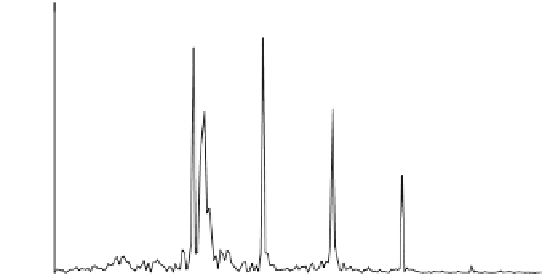Geoscience Reference
In-Depth Information
100
ψ
1
K
1
80
S
1
FCN
60
P
1
40
20
π
1
0
−3
−2
−1
0
1
2
3
4
Celestial frequency [cycles per year]
Fig. 15
Amplitude spectrum of long-periodic nutational motions associated with thermal tides in
the atmosphere that can be allocated to the retrograde diurnal band in the terrestrial reference frame.
The spectral content of
S
1
(main sun-synchronous tide) and its side lobes
{
ψ
1
,
K
1
,
P
1
,π
1
}
has been
obtained from six-hourly equatorial AAM function values for the time span 1980-2010
according to Dickman (
2005
) causes only marginal changes of
5%) and the
resulting motion term coefficient in Eq. (
87
). However, the modification of the load
Love number
k
2
in Eq. (
86
) suggests a matter term coefficient of 1
σ
e
(
<
0
.
.
09
/(
C
m
−
A
m
)
instead of 1
, cf. Table
1
. This error is slightly larger than the level of
inconsistencies we accept when replacing both
.
00
/(
C
m
−
A
m
)
σ
1
=
Ω/
402
.
6 and
σ
e
=
Ω/
429
.
1
by the observed Chandler frequency
σ
cw
=
Ω/
434
.
3 (the difference in periods is
about 7%).
A further theoretical conflict emerges when realizing that
w
, associated
with an essentially core-less Earth model, relate via Eq. (
90
) to the NDFW/FCN
resonance, which actually arises from the existence of Earth's oblate, liquid core.
The numerical impact of this mismatch is small, though, and can be estimated by
comparing the coefficients of
p
and
χ
χ
Δ
I
and
h
for the Barnes et al. (
1983
) formalism (see
Table
1
) and that inherent to Eq. (
82
). Both sets of scaling factors agree within 1.5%.
Within the given limitations, the theory of Brzezi nski (
1994
) accounts for rota-
tional deformation and crustal loading, but being bound to the dynamical equation
of Sasao and Wahr (
1981
), it does not include additional factors, such as mantle
anelasticity or the wobble response of the oceans and the core. Theoretically, it
should be possible to incorporate further rotational feedback phenomena into the
extended polar motion equation by an appropriate change of its parameters. How-
ever, at present recognized models for those effects at diurnal time scales are not
available (see also Sect.
2.4
) and this adds to the absence of a dynamical model that
accurately characterizes the response of the oceans to atmospheric forcing at short
periods. There is a strong necessity to correctly model these indirect effects on Earth
rotation in the diurnal frequency band, if a thorough verification of geophysical data
versus geodetic observations is envisaged.































